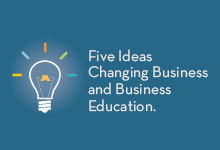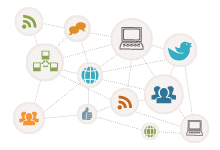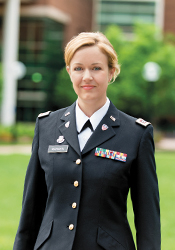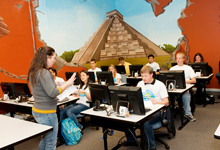Five Ideas Changing Business and Business Education
Tuesday, February 5, 2013
Earlier today, I had the honor of addressing alumni and friends of the Carlson School at the 1st Tuesday Speaker Series at McNamara Alumni Center. Below are my prepared remarks.
How lucky are we to be alive today, in 2013! These are indeed fascinating times! I can't remember how we functioned less than 20 years ago without email, 15 years ago without Google, and a mere five years ago without the iPhone!
These are times that are simply exhilarating -- and challenging -- for society, for business and for higher educational institution s like the Carlson School. Being right in the middle of so much change, I wrestled with which of a hundred different directions I could take this talk, and decided to focus on just five big ideas that I believe are changing both businesses and business schools, and tell you a bit about what we, the Carlson School, are doing about it.
1. Expectation of Everything, Everywhere, Anytime
The first big idea and the one I will spend the most time discussing is this - Our Expectations of Everything, Everywhere, Anytime. When was the last time you were sitting in a group and someone wondered what the population of, say Duluth, was, and someone else pulled out their smartphone and had the answer in seconds? Probably not long ago. We're now in an era where we're expecting everything at our fingertips no matter where we are and what time it is. Waiting is not for us.
Waiting is also not for our students. The need to be constantly connected and instantly gratified is playing out in spades in the educational space. Our students expect and demand all of our offerings and materials to be online and mobile -- everything, including education -- at their fingertips at all times. This creates enormously interesting opportunities for us, to use technology to both improve education and make it more accessible, not just by using online methods, but by being able to motivate, engage, and educate our students with the whole slew of technologies that are already at hand - mobile, video-game like learning games and incentives, perhaps apps that remind students to start on homework, crowdsourced ideas, you name it!
In this landscape, the interesting question for me isn't at all "to go to online education or not to go online" -- that horse bolted the stable some time ago. We are already online in major ways. As we go forward, we will be using ALL of the digital technologies available to enhance learning AND convenience for all our students, and the experiments we have to do, the investments we have to make to make this happen, create a fascinating, fun and undoubtedly challenging time for higher education. What an absolutely heady time to lead an educational institution!
So if the right question isn't "to go online or not", what is it? To me, the bigger question is quite different. I see higher education going in two parallel directions, both directions (and this is very important to understand), using online and digital technologies to the hilt, and the closest analogy I can think of is the parallel universes of fast food versus slow food. You have the McDonalds of the world, and you have the Bachelor Farmers and La Belle Vies - or my favorite restaurant -- the Victory 44s -- of the world.
The fast food version of education will be massively scaled and scalable -- there will be perfectly-developed bite-sized modules accessible to everyone, if not for free, then for perhaps 99 cents a class, or $9.99 per course. I'm not worried about the business models for these Massively Open Online Courses (or MOOCs as they are called). The quality courses will find sustainable business models. We all got used to paying for the New York Times after the first few free articles. Very high volumes, low margins, accessible to everyone, but --- not necessarily the healthiest educational nourishment for everyone. Completion rates will remain low. It really won't work for even the slightly unmotivated, and is certainly not the way you want to go with your 18 year old in the basement, who you want to go away, live in a dorm room with someone completely different than themselves, and learn to look people in the eye, smile and develop some leadership skills, while they get an education and turn into responsible adults.
There will be institutions that focus exclusively on the highly-scaled end of the market and work to become the McDonalds of education. The Open University in Britain already works this way, with an amazing capacity to reach out to hundreds of thousands of students, with over 7000 course modules. They create these modules in partnership with the BBC, in teams that include faculty members and producers and cameramen and educational technologists. These modules are not cheap to develop -- each module take two years on average -- with repeated focus-group testing on real students. At the end of it, they have the perfect educational Big Mac -- a bite-sized educational offering that is brilliantly crafted, enhances learning and can be rolled out to millions of people. At their best, this is what the Massively Open Online Courses or MOOCs could evolve into.
But what nourishment are you missing out on when you get the Big Mac instead of the three-course meal? As one of our faculty members, Professor Chris Cramer in Chemistry, said recently, "We've always had MOOCS - they were called books!" They may be better books and more accessible to those without libraries, but educational nourishment has to provide more than that. With the slow food version of education, we will still use all the digital technologies available including online, to deliver an enhanced and more convenient learning experience, but there will be a master teacher who can look someone in the eye and say "how would you have acted differently, and why?" Someone who can inspire students, as Professor Myles Shaver in our Strategy department, who was listed as one of the 50 best business professors in the world. Myles, with his Socratic approach, constantly pushing, constantly questioning, not accepting the standard response, helps students every day understand how to question assumptions, how to make the uncommon connections. Myles, where are you? He can even make them think about how the lessons of curling -- Myles is Canadian -- apply to Corporate Strategy. This slow food model of education isn't as scalable - if anything, to be competitive in delivering this really well will require creating a more intimate experience, particularly at the undergraduate level -- between teacher and student, and among students. We have to use technology to, as my fellow Dean Leon Assael of Dentistry puts it, create the feel of the residential college model, or even an apprenticeship model.
Don't get me wrong. The fast-food equivalent offerings can be very effective for the right learner -- for motivated students and professional students who don't have easy access to anything else, or who need a specific skill right here right now.
So where does Carlson stand? We will pick slow. And we will pick fast. The two are not incompatible -- technology and ideas developed for one will enhance education in the other model. What are we doing about this? We already have faculty working on using technology to enhance both the fast and slow (or maybe I should call it the VAST and the COLLEGIAL) versions of education -- increasing the number of online courses offered, experimenting with formats, and flipping the classroom, as Professor Colleen Manchester in our Work and Organizations group is doing - where are you, Colleen? Colleen has completely changed how she teaches her intro stats course by making students watch the lectures at home, and spends class time working on problems with the students. Expect also to hear a major announcement from the U by the end of the month on what where the University is heading in the scaled up VAST version of education.
2. Rise of Social Influence
A second big idea changing businesses is how messages reach individuals. This is a picture from our alumnus, Rob Cain, who is the CIO of Coca Cola. In the beginning was the broadcast message - one message for everyone. That moved to segmented markets receiving different messages, then to messaging directed to individuals. The direction we are moving in now is to recognize that the individuals or even the individual businesses we are trying to reach are not atomistic - they are embedded in networks -- and are being influenced by key individuals in their networks. For example, I get all my news about software issues from one Facebook friend who is a tech geek, and all my leadership reading from another Facebook friend who is singularly focused on that subject. They are curating my reading for me. In the B2C and even in the B2B space, which products get accepted in the marketplace and which fail is often being driven by individual influencers as they blog, tweet, and post online. Understanding social networks and how peer-to-peer influence flows through these networks becomes extremely critical for businesses and for individuals.
What are we as a business school doing about this? Our faculty are already among the leaders in this field. By collaborating with the College of Science and Engineering and other areas of the University to form the Social Media and Business Analytics Collaborative (or SOBACO in short), we're able to take a much more scientific approach to these issues and conduct real-world experiments in the social media space that will likely change how companies market and operate in the not-too-distant future. We are partnering with businesses -- some of which are represented in the room today -- to understand how peer-to-peer influences spread. Just two weeks ago, for instance, we had an amazing conference on social media in collaboration with MinneAnalytics which drew over 800 people to the Carlson School on one of the coldest days of the year.
Not only are social media platforms changing how we do business, they are revolutionizing the most basic of human activities such as friendship and love. Did you know that 45 percent of the single population today initiates their search for a new relationship online? For the first time ever, SOBACO faculty are quantifying these age old social behaviors by running experiments on how trust forms in online networks, how peer influence spreads and even examining online dating patterns, and are in the process of discovering ways to reduce what they call social frictions in building trust and relationships. Fun stuff, isn't it? (and you thought academic research was boring!). More seriously, the research being done in SOBACO is likely to open up whole new ways in which marketers decide how to influence consumers, and provide all kinds of new insights through big data analysis. At the Carlson School, we hope to help the state of Minnesota become a data science hub -- we expect to launch a Masters program in Business Analytics and Data Science next year, and we are already providing short courses in executive education in this area. And I might add, here too is a wonderful example of the critically important role the University of Minnesota plays in creating long-term strength and competitive advantage for our state.
3. Getting Beyond Globalization
Coming to the third big idea, at some level, globalization is such a 20th century concept. The idea that you're going to be selling products around the world, or outsourcing your production or even the idea that you'll be looking to the developing world for innovation and bringing it back to the developed world still sees the world very much as "us" versus "them."
Us versus them may still be the overarching framing for foreign policy, although I don't think it really works even there, but for business, it is very clear we need to move to an "us" and "them" world. There are opportunities -- problems requiring answers -- everywhere in the world. There are solutions all over the world as well. Your ability as an entrepreneur, as a business leader, to bring opportunity and solutions together can only happen if you see the world as your oyster. How do we create a mindset in our students that sees the world as "us" AND "them?"
We've taken a big step by insisting that all of our students have an international educational experience, and it is widely recognized that the Carlson School is at the forefront in this movement. And you only have to meet Steele Lorenz, one of our recent Undergraduate alumni, to see that our approach is working.
At the Carlson School, Steele became active in our Ventures Enterprise. As it does for many, the Ventures Enterprise opened his eyes to a whole new side of business and in turn a new world of possibilities. Sensing his passion, Toby Nord and Connie Rutledge, our Ventures Enterprise directors, encouraged Steele to join the Acara Challenge, an interdisciplinary course and competition that involves the College of Science and Engineering, the Institute on the Environment and the Carlson School, and pairs student teams from the University, with partner schools around the world to create businesses that can solve an environmental challenge.
Our student Steele Lorenz did just that and less than two years after graduating, this young man from Green Bay, Wisc., resigned from his job as a consultant to turn his Acara Challenge idea into a reality. Today, Steele is in Madurai, India, near my hometown, and his company, MyRain, is helping small farmers improve their yield and make their farms sustainable through a simple, cost-effective drip-irrigation kit. It's a truly remarkable story that showcases the opportunities that exist for those ready to embrace an "us AND them" mindset.
4. A Looming Talent Shortage
I'm sure you have all read the recent Wall St Journal report on the coming Baby Bust and the fact that US birthrates have dropped below the population replacement rate. While that seems a bit distant, more ominously, I recently heard Terry Fitzgerald of the Minneapolis Fed show some pretty convincing demographic data on how Minnesota is going to be losing population relative to the rest of the country in the next 10 years. Maybe our winters aren't long enough!
For us to remain as economically vibrant as we are today, our firms must be able to attract and retain the best and brightest talent from around the world. I cannot over-emphasize the role played by a world-class university and world-class business school in making this happen. But to overcome this lowered population growth and both keep and grow our talent, we are going to have to do much more. We have to be inclusive. We cannot afford to leave any group out or make anyone feel unwelcome here.
We have to do everything we can to get the best talent from diverse backgrounds, races, orientations into business education. We also have to figure out how to keep them - particularly women. Some estimates cite as many as 30 percent of post-MBA women are no longer in the workforce. What a lot of incredible brain power that is lost, and we need to change both policies and culture. I was one of those women who took time off during child-rearing, and am the mother of a professional woman who is wrestling with these issues. I had the opportunity to re-enter the workforce at age 37, thanks to education -- in my case a PhD -- and I am absolutely passionate about the cause of providing women opportunities for career re-entry.
How does the business school fit into this? Education, especially education for working professionals, is one of the best ways to re-engage talent in the world of business. At the Carlson School, we offer a host of options -- the Part-Time MBA, the Executive MBA, and executive education programs to retrain and develop working professionals. We also host a variety of networking events, e.g. Women in Finance, and the Women's Leadership Conference to help women advance their careers. We make significant efforts to reach out to underrepresented minorities - I was at a Diversity admissions event just last week where we had 33 potential students from all over the country - California, Baltimore, Chicago - out in our warm school on the coldest day of the year. But we need to do much more. One of the reasons women and minorities do not pursue higher education is also that they do not feel that they can strain the family budget by spending it on their own education. So I will be calling on all of you for more graduate fellowship help, especially for women and minorities.
The Carlson School, particularly our Full-Time MBA program, also serves as a magnet that draws future leaders to this community. Each year we are bringing some of the brightest young business minds from around the country and around the world to Minnesota to attend our Full-Time Program. And many of them discover what I did 21 years ago -- once you get here, it's really hard to leave. A major focus of mine as dean is to grow our Full-Time Program and recruit even more students from outside the region. One way we are doing this is through a new Military Initiative.
Our military veterans possess tremendous leadership skills that can be an asset to any organization - what they often lack is corporate experience and the language of business. Well, we are as good as any school in the country at providing that experience. If you read the last Carlson School magazine you saw a great example of that. Karly Mangen, a National Guard Commander came to us a few years ago with absolutely no formal business background. But for 15 months she worked in our Brand Enterprise doing real marketing projects for real companies like Thrivent and Best Buy. Those projects gave her access to senior management at these companies in experiences that rival or top someone who might have spent their early career in marketing. And they're why she is now in her dream job at General Mills as an associate marketing manager in the Yoplait division.
We hope to have a lot more stories like Karly's and we recently hired Retired Navy Commander Chip Altman to help us recruit more military members and veterans. Chip has already exceeded our expectations as seven students with military backgrounds began our Full-Time Program this fall including David Obray, a former soldier of the year!!! David was selected No. 1 out of the 1.1 million who were serving our country in 2008. Can you imagine the impact he'll have on one of your businesses after his two years at the Carlson School!?!
We must find a way to help even more of our servicemen and women make the transition from military to business careers and are working to make that happen. It's good for our school. It's good for our businesses. And it's the right thing to do.
5. Focusing on the Why and the How (Not just the What)
Just recently, I read a Wall Street Journal piece in which Bill Gates talked about fixing the world's problems by measuring them. This focus is very much on outcomes. Setting clear goals and finding measures that will drive progress towards that goal. This is something that has been a cornerstone of management all along - that we need accountability and metrics and should focus on goals and outcomes.
That's all great. But at the same time that we are focused on outcomes, we cannot lose a sense of the Why and the How. We must ask, why are we doing certain things? And how? And are we really focusing on the right outcomes and metrics, given our greater mission?
This requires us to understand the purpose behind any business. It requires business leaders to be able to go beyond mere metrics to imbue their mission with meaning, and be able to convey that meaning to others within their organizations. Steve Jobs wasn't focused on an outcome or on how many iPhones he was going to sell. It was about creating technology and designing products that changed the way we live. That greater purpose of business is something we should all think about, each day. Why do we do what we do? Students who come to us are looking for meaning - for purpose-driven careers, and businesses that can convey this sense of purpose, provide that larger meaning, have the best chance of attracting and retaining talent, and finally also getting the outcomes they desire.
What are we doing along these lines with our students? While they are with us, we really encourage them to expand their horizons beyond the business school. Apart from leadership in the program, we encourage them to look for meaning outside the classroom, and in the community.
I am so proud of the work that our students do outside the classroom and the commitment that they have to a greater purpose. With that in mind, I'd like to end with a video that many of you received over the holidays that showcases Carlson School's commitment to making business a force for the good.
Thank you for being here and thank you for all that you do for the Carlson School of Management and the University of Minnesota!





